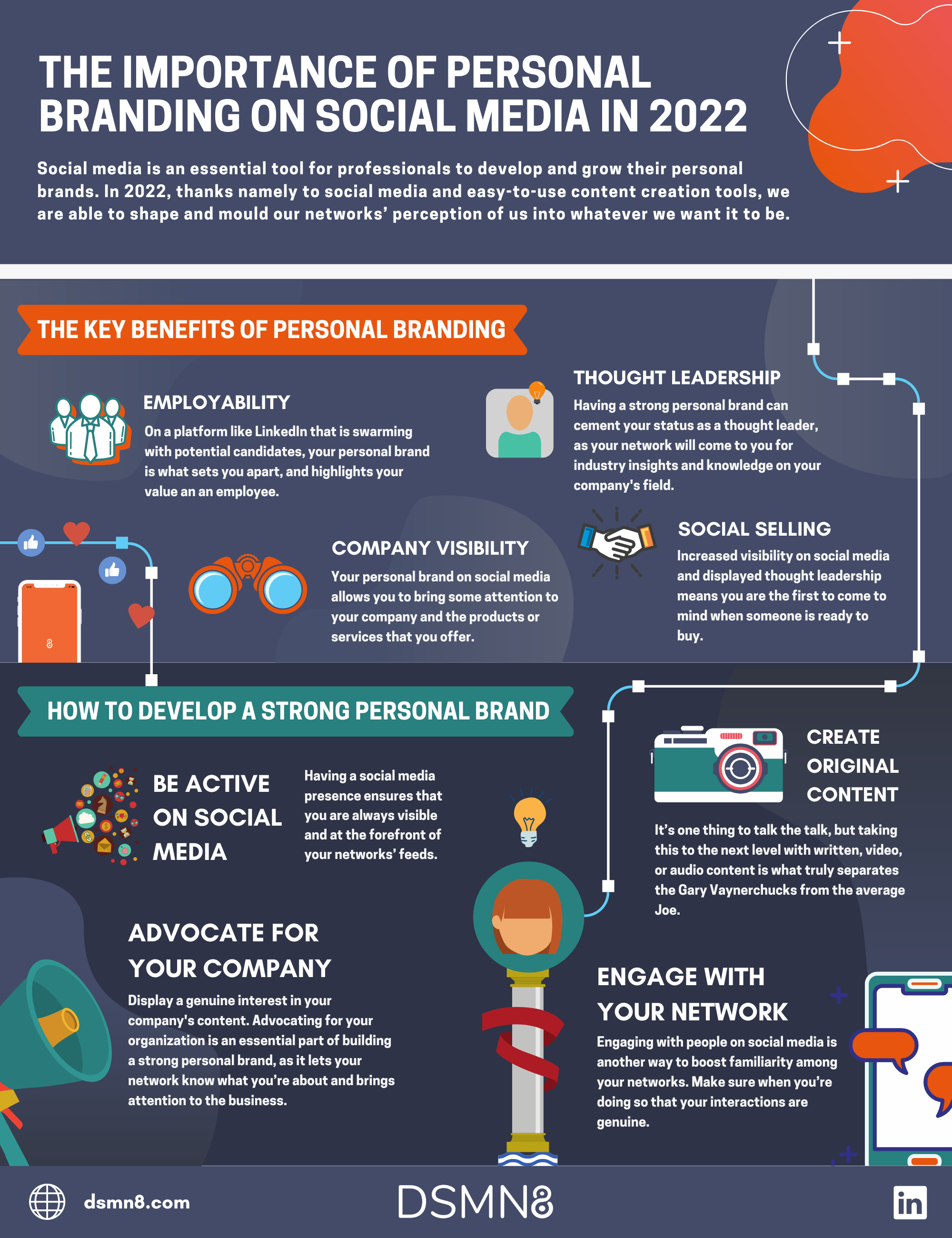
If you’re reading this, it’s too late 😱
JK.
If you’re reading this…
It’s because you’ve decided to give employee advocacy another go.
And so, if you’re reading this, it’s because you KNOW what’s possible with an employee advocacy program and you’re determined to make it work! 🔥
Rest assured, here at DSMN8, we’ve been helping launch and run hundreds of employee advocacy programs since 2016, so we have a few tricks up our sleeves.
Whether you adopted this program from your predecessor or oversaw it from day one, we need to start by taking it back to the beginning.
They say we should learn from our mistakes, so let’s start by looking at your original attempt at launching a program and determine why employee advocacy failed for your organization.
Jump to:

Identify WHY Employee Advocacy Failed for You
“Those who do not learn their history are doomed to repeat it.”
If you think your employee advocacy program has gone stale and want to reboot it, or if you’re starting over from scratch, then it’s important to identify why your first attempt at employee advocacy failed.
Otherwise, you could launch the best program and repeat these same mistakes, causing users to drop off and results to suffer as they did the first time.
DSMN8 Commander-In-Chief, Bradley Keenan, covered this topic in brilliant detail on a recent episode of The Employee Advocacy & Influence Podcast 👇
Our top tip and the main takeaway – speak with the people who used the program.
No doubt, you will know a handful of people who used your platform more frequently than others, and you may even have had a few “super users” who not only used the platform more than others but also drove some of the most significant results! 📈
THESE are the people you need to speak with for the best feedback on the first iteration of your employee advocacy program.
Now, in these instances, it can be tempting to look for confirmation biases and to find out what people loved about the program, but what you’re looking to do here is find out why people stopped using it in the first place.
People will rarely stop using something because they got bored of the things they liked. You need to find out why they became disengaged and what eventually led them to drop off altogether
This could be anything from the tool/technology not being good enough to the content not resonating with them 🤷♂️
Whatever it is, this is arguably the most valuable feedback you can receive.
Consider writing a small survey with questions about your original program and emailing it to these people.
Okay, so let’s look at how to succeed with employee advocacy 👇

Lay the Foundations
When it comes to laying the foundations for an employee advocacy program, there are two things you absolutely need to cover:
- Creating an employee advocacy-ready social media policy
- Identifying your Employee Value Proposition
Let’s start with your social media policy.
For years, the consensus around posting on social media has been “if you talk about our company on social media, you’re in big trouble” or something to that effect 🤦♂️
So, naturally, if this change in attitude towards “post more on social media” isn’t communicated, then your employee advocacy program will fall at the first hurdle.
You HAVE to either update or create your social media policy so that it’s ready for an employee advocacy program, and you must ensure you’re getting this in front of people. Don’t hide it on page 92 of your employee handbook; definitely don’t make it 20+ pages of black and white text full of legal jargon. Nobody will read it, and as a result, nobody will go near social media 😩
Fear not! We’ve got covered. Grab a free and fully-customizable social media policy template 👇
Okay, so next up – identify and communicate your employee value proposition.
What do we mean by this? Well, put yourself in your colleagues’ shoes.
If you work in marketing or communications, you’ll know the importance of having a presence on social media. But your wider workforce will likely be thinking:
“Why share content? What value is it to me?” 🤔
Don’t focus on the value they’ll be bringing to the organization. Focus on them as individuals and talk to them about how being an employee advocate will help them develop in their career, both internally and potentially externally, as they build their own social media community that they can leverage for years to come.
Check out this infographic on the importance of personal branding and ensure you’re communicating these points to your team from day one 👇
Consider Gamification
Maybe you’re not looking to start over and just want to reignite your current program?
Well, it might be time to give gamification a go 📊
Okay, this one is widely debated, but gamification in the form of leaderboards and rewards can be an excellent way to bring some excitement to your employee advocacy program and to get people using it more.
It’s debated because, in theory, your colleagues shouldn’t need an incentive to start using your platform if you’ve communicated the employee value proposition from day one.
However, there’s no denying that some simply won’t see enough immediate value for them to prioritize it 👍
Take software engineers, for example. Sales and marketing teams will see the immediate value because it can impact their day-to-day performance by being active on social media, whereas the benefits for a software engineer and fewer and take time to develop.
Gamification, in these instances, can be a great lever as it incentivizes your less-motivated employees to do more within the platform. It creates a friendly competitive environment, and the nature of winning encourages more sharing 🙌
Check out how Chinese tech-titans, Huawei, leveraged gamification to triple user adoption rates!

Get Senior Leaders Involved
One thing that’s always going to help reboot your employee advocacy program?
Get more senior individuals involved
The sky is the limit here.
Don’t just stop with your line manager.
Or your friend who manages a sales team.
Shoot for the stars! 🤩
If it’s possible, get the C-Suite involved.
There are two reasons why this works…
The first is that they HAVE to lead by example.
Nothing will say, “I don’t believe this is important enough to use, and neither should you”, like asking your colleagues to take part when the people at the top won’t.
The second reason is that no employee will realistically be able to not use something their line manager (or higher) is using and reaping the benefits from.
If, for example, a sales director or CRO was using your employee advocacy platform to build their network, start conversations with prospects and book meetings from social media, would any SDR be able to say no to doing the same? 👌
If you’re about to launch a new employee advocacy program from scratch, then this is something you’ll want to try to do from day one.
Not only will your senior leaders lead by example, but they’ll also be able to help you with your awareness communications to get the word out about your employee advocacy program 💪

Free Set Up Guide
Fortunately, we’ve wrapped up all this wisdom into a comprehensive guide to getting set up for success.
So, whether you’re looking to launch an employee advocacy program from scratch or just looking to reboot your existing program, there’s something in here for everyone! 🥳
Including learnings from our customers to top tips from our customer success team; grab your guide and get set up for success with employee advocacy.
People Also Ask:
Who should join my employee advocacy program?
It’s a common misconception that only sales, marketing and communications teams can make an impact when it comes to employee advocacy. The truth is anyone can make a significant impact, no matter their job role. We identified 5 types of employees that every company has and outlined the impact each can make with ‘The Pyramid of Employee Influence‘.
When should employee advocacy be incentivized?
As mentioned, gamification is a highly debated topic in the employee advocacy space. While we tend to say it should be reserved situations when you need to reignite your program, there are some great examples of there of companies who leveraged gamification from day one to get their colleagues involved. Here’s a piece on deciding when to incentivize employee advocacy (if at all!)
Related Podcast Episode
Ready to get started with employee advocacy?
Prefer to speak with us first? No problem.
Schedule a call with one of the team.
More content you might enjoy:
Lewis Gray
Senior Marketing Manager and Employee Advocacy Program Manager at DSMN8. Lewis specialises in content strategy, growing brand visibility and generating inbound leads. His background in Sales lends itself well to demand generation in the B2B niche.




